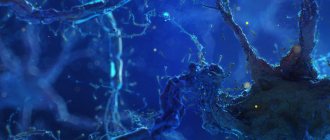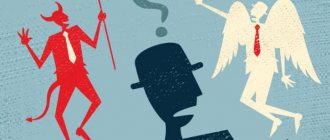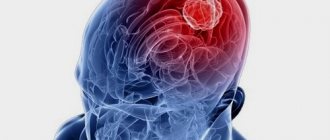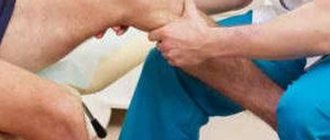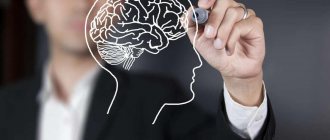Today we have a new article from the “About Sleep” series. An article about a strange, mysterious, little-studied disease - Kleine-Levin syndrome. In total, about 200 cases of recurrent hypersomnia, a pathological hibernation into which a person plunges for days and weeks, are described in the medical literature.
A beautiful fairy tale by Charles Perrault tells of a princess who slept in an enchanted sleep for a hundred years.
This is a fairy tale, but in real life a person can sleep from several days to several weeks, waking up only to go to the toilet and eat. Moreover, sleep overtakes him in any, most inappropriate place, regardless of the time of day.
Chronologically, the analysis of the disease looks like this:
- 1786 - the first scientific study of periodic hibernation syndrome by the French physician de Beauchaine;
- 1925 - a detailed description of the symptoms and manifestations of the pathological condition by the German psychiatrist Willy Kleine (Klein) in nine patients;
- 1936 - United States neurologist Max Lewin adds five new episodes. Lewin’s diagnosis made it possible to identify a focal point - a combination of “sleeping attacks” and an abnormal change in eating behavior, that is, the value attitude towards food.
Max Lewin was the first to classify SCL as a disease of neurology, not psychiatry.
“Kleine-Levin syndrome” (KLS) is the most common name for the disease.
In medical practice, its synonyms are also used: periodic hibernation syndrome, periodic hypersomnia syndrome, sleeping beauty syndrome.
Causes
SCL is considered a rare pathological condition with an incidence of 1-2 per million. Neither the causes nor the triggering mechanisms of the disease have been studied so far.
MRI of the brain, cerebrospinal fluid samples, and studies of daily fluctuations in hormone levels did not reveal any critical abnormalities.
In some patients, a decrease in metabolism was recorded in the thalamus and hypothalamus, in the temporal lobes of the brain.
The changes are stable: they do not worsen during attacks and do not disappear during remissions. That is why we can only talk about theories of the occurrence of the disease or factors that may provoke it.
Development theories
Genetic theory
When someone in the family suffered from periodic hibernation syndrome. Gene mutations lead to disruptions in the functioning of those sectors of the brain that are responsible for normal sleep and hunger.
The theory is supported by the fact that it occurs most often among Ashkenazi Jews, regardless of which country in the world their representatives live in. Why the disease “chose” this particular people remains unknown.
The theory of brain dysfunction after neuroinfections
Here, we primarily consider meningitis - inflammation of the lining of the brain and encephalitis, viral or autoimmune - inflammation of brain tissue with predominant damage to the hypothalamus.
In some cases, SCL was observed in combination with tumor formations in the brain.
Theory of hormonal changes in the body
In the vast majority of cases, the initial episodes appear during puberty, when the level of hormones either rises to a maximum level or falls to a minimum.
Pathological sleep in this case is a kind of protective reaction of the body.
The theory of hypothalamic-pituitary dysfunction. Recent studies have revealed disturbances in metabolic processes in the hypothalamus.
Theory of death or failure of orexin neurons
It is the orexin system that, among other things, is responsible for the sleep-wake cycle and regulation of nutrition and energy.
With a lack of orexin, behavioral manifestations of sleep and muscle tone are disrupted, and narcolepsy develops.
Trigger factors
They are not causes in themselves; they are rather levers that influence the triggering mechanism of the disease:
- damage to the fetus during the prenatal period;
- mechanical brain damage;
- viral infections;
- tumor-like formations in the brain;
- permanent stressful situations.
Factors in the development of the disease
The nature of the disease has not been fully determined. Most neurologists and psychiatrists tend to assume that the syndrome is based on an autoimmune etiology. The principle of the theory is that as a result of a cold, encephalitis develops, limited only to the hypothalamus zone. This section contains cells that produce elements (orexins) that affect drowsiness and wakefulness. Inhibition of orexins reduces the production of a substance that excites the cerebral cortex. The body goes into a sleep state.
During the period of age-related changes in the body, hormonal disruptions occur, which serve as a favorable basis for the development of pathology. The disease can also be triggered by traumatic brain injury, viral infection, generalized infection (sepsis), and long-term high body temperature. Cases of familial incidence are recorded, which suggests the genetic nature of the anomaly. So a number of experts believe that the syndrome is congenital, genetically determined. This disease develops under the influence of hormonal changes in adolescence, with the presence of provoking factors.
How it manifests itself
Representatives of any race and any nationality are susceptible to the disease. Moreover, the largest number of cases was recorded among Ashkenazim.
Sleeping beauty syndrome is a disease of the young. It appears at puberty and is most often observed in teenage boys 12-16 years old. In girls, it occurs less frequently and is associated with surges in progesterone levels.
With the completion of hormonal changes in the body, all symptoms, as a rule, disappear. As a rule, because a case of the disease was recorded that lasted 18 years.
Sleep can last 16, 18, 20 hours. Its longest duration was 6 weeks. The frequency of episodes of drowsiness has not been established. The attacks can follow one after another, and can be weeks or months apart.
At the end of the sleep episode, the person is overtaken by a bout of gluttony. The appetite after waking up is indomitable, the patient eats everything that “comes to hand” in unlimited quantities. At this moment, there are no taste preferences; even those foods that previously caused persistent disgust are absorbed.
Despite all this, eating food in gigantic quantities does not bring either satisfaction from its taste or a feeling of fullness. Moreover, sometimes completely inedible objects are used.
Attempts to wake the person are unsuccessful. If, nevertheless, the patient can be forcibly brought out of the state of sleep, upon awakening he becomes angry and aggressive.
In this state, the patient swears and insults loved ones, but cannot cause significant physical harm due to a constant feeling of fatigue and weakness.
During the “sleep-wakefulness” period, the patient experiences unclear and confused consciousness, lacks logical thinking, and experiences disorientation in space and time.
In addition to other disorders, amnesia occurs for recent events; firmly acquired information is either completely erased from memory or reproduced with great difficulty.
In some patients, persistent visual and auditory hallucinations appear in the period of time between sleep and wakefulness.
As a rule, a person is haunted by ideas that they want to kill him, poison him, or cause physical harm. Everyone around you is perceived as enemies.
The patient becomes distrustful and suspicious of those closest to him.
A specific manifestation of the disease is sensitivity to minor stimuli. While awake, noise outside the window, loud conversation, too harsh and bright light cause discontent and aggression.
Men suffering from Kleine-Levin syndrome may experience sexual behavior disorder. Cases of hypersexuality and sexual harassment have been reported.
As symptoms subside, all cognitive abilities are fully restored. Both mentally and physically people look completely healthy and can lead a completely normal life.
Stories of people with Kleine-Levin syndrome
The world learned about the British Helen Waters in 2014. She was born in 1977. As a child, she was considered slow and clumsy. Therefore, the girl had no friends among her peers. She even spent her summer holidays alone. The doctors thought it was just laziness, so they didn’t conduct an examination or make a diagnosis.
In her youth, Helen did not become more active. She was constantly haunted by a feeling of fatigue. In 2009, she fell ill with the flu. After treatment, I hoped to start working, but I fell asleep for a whole 3.5 weeks. Her parents were only able to wake her up and feed her a few times. After fully waking up, everyone was convinced that Helen was sick with something.
From that moment on, tedious trips to hospitals began. Doctors, tests, examinations could not really say anything. At first they thought it was depression. But the prescribed medications did not help. And only after additional research was carried out, experts were able to understand what happened to the girl. The diagnosis, as you understand, is “sleeping beauty” syndrome.
Now Helen cannot live without medication. If she tries to at least reduce the dosage, the period of wakefulness is sharply reduced. An unpleasant consequence of constant sleep was partial memory loss. Sometimes a girl does not recognize her family and friends in a photo from a family album.
Diagnostics
The first step in diagnosis is drawing up a life history and medical history. The diagnosis of SCL is based on the following criteria:
- abnormal sleep duration – from 16-29 hours. The appearance of “sleeping attacks” 1-2 times a year;
- feeling tired and apathetic after waking up;
- hyperphagia – bouts of gluttony upon awakening;
- uncontrollable nervousness and aggression;
- the appearance of visual and auditory hallucinations;
- sweating during sleep and upon awakening. Blueness of the palms, fingers and toes, lips and nasolabial triangle;
- drop in blood glucose levels;
- hypersomnia is not combined with neurological and mental disorders such as epilepsy or depression;
- the syndrome is not combined with pathological conditions such as apnea (cessation of pulmonary ventilation) or myoclonus (involuntary shudders at the moment of falling asleep);
- absence of enuresis.
Instrumental diagnostics are of secondary importance and include:
- electroencephalography. Allows you to record and decipher the functional activity of the brain. With SCL, low-amplitude peaks of the localization zone are recorded - the temporal and temporo-parietal zones;
- polysomnography. Allows you to identify a shortening of the 3rd and 4th phases of sleep, a decrease in the period of falling asleep;
- PET-CT of the brain. During the period between attacks, no changes are recorded. During exacerbations, a disturbance in the blood supply to the brain is detected in the areas of the thalamus and hypothalamus.
Attention is paid to differential diagnosis. Kleine-Levin syndrome is differentiated from depression, narcolepsy, and encephalitis lethargica.
Sleeping Beauty Syndrome: Symptoms of a Sleep Disorder
Sleeping 18-20 hours a day is a pathology called sleeping beauty syndrome or Kleine-Levin syndrome . The disorder is accompanied by severe drowsiness, which is difficult to overcome. A person gives in to the call of the body and sleeps for as much time as possible.
It is quite difficult to wake a person in such a state. If you manage to do this, after waking up he will be overwhelmed, which is why the attack of irresistible drowsiness will happen again, and the person will fall asleep again for ten hours.
- Description
- Symptoms
- Causes
- Diagnostics
- Treatment
- Prevention
Description
Kleine-Levin syndrome is a rare and poorly understood disease. Cases of its occurrence are rare, and the exact causes are unknown.
Prolonged sleep with such a pathology is harmless to health. However, being constantly in bed interferes with normal life. A person’s performance decreases, problems appear in his personal life, and academic performance decreases.
Symptoms of the pathology arise and disappear spontaneously. After 25 years, the disease almost never occurs. With age, sleep disorders appear less and less often, and then suddenly disappear.
In ICD-10 , the international classification of diseases, 10th revision, Kleine-Levin syndrome refers to diseases of the nervous system, or more precisely, to a subcategory of sleep diseases. Sleeping beauty syndrome is indicated by code G 47.8
Diagnostics
If you notice Sleeping Beauty Syndrome in yourself or a loved one, you should consult a doctor. The problem is dealt with by neurologists and somnologists .
Make an appointment with a sleep specialist online
After examining and asking about symptoms, the doctor will send the patient for polysomnography - sleep diagnostics at the medical center.
To undergo it, the subject comes in the evening to a specialized institution, where he is prepared for bed with the equipment connected. Before the procedure, sensors are attached to it that monitor breathing, pulse, oxygen levels in the blood, brain activity, etc.
The data is transmitted to the medical staff’s computer, with the help of which specialists monitor sleep indicators in real time.
Should you undergo polysomnography?
On polysomnography, sleeping beauty syndrome is manifested by a reduction in REM sleep . Because of this, the quality of sleep deteriorates. Roughly speaking, 8 hours of sleep in such a patient is equivalent to 2-3 hours of rest for a healthy person. And to get the norm of healthy sleep, patients with Kleine-Levin syndrome sleep more than 18 hours.
Polysomnography also shows delays in sleep phase changes. It turns out that the next stage of sleep does not occur for a long time, and a person can stay in one phase for hours.
What is REM and NREM sleep?
Additionally, for diagnostic purposes, MSLT testing (multiple sleep latency test) is performed, which determines a person’s need for sleep. MSLT is usually performed after polysomnography.
During the MSLT test, the patient tries to fall asleep several times over a certain period. Specialists located nearby use polysomnographic equipment to record the time of each fall asleep. The faster a person falls asleep, the more this indicates sleeping beauty syndrome. Pathology is considered when the average time to fall asleep is less than 5 minutes.
Hypersomnia - how to get rid of constant sleepiness?
Sometimes the patient is sent for an EEG - electroencephalography . However, research usually does not show significant changes in the brain in this disorder.
Computed tomography of the brain performed during an attack of hypersomnia demonstrates dysfunction of the hypothalamus. Recall that the hypothalamus is responsible for the sleep-wake cycle.
Prevention
The following tips will prevent the initial or recurrence of the syndrome:
- You need to sleep 8-9 hours a day. Try not to stretch out your sleep, but also not to shorten your rest hours.
- You need to go to bed and wake up at the same time. The regimen promotes the correct flow of sleep and wakefulness cycles.
- During the day you can sleep no more than 2 hours.
- 1-2 hours before bedtime, you should reduce physical activity. That is, there is no need to play outdoor games or play sports.
- It is not recommended to play computer or mobile games before bed.
- There is no need to drink or eat foods that stimulate the nervous system at night. This includes coffee, all types of tea, cola, dark chocolate.
- You should not overeat before going to bed, and you should not go to bed hungry.
on this topic:
Treatment
Due to the fact that the causes and mechanisms of development of SCL are unknown, there is no treatment protocol. We can only talk about symptomatic and palliative (supportive) therapy and psychological assistance.
Psychological treatment
Psychological treatment methods are effective for mild forms of the disease; they not only reduce periods of drowsiness, but also support the patient:
- Psychoanalysis. A long-standing and widely used practice based on Freud's theory and teachings about the combination of the conscious and unconscious, about secret sexual desires and hidden experiences. The psychotherapist invites the patient to express everything that torments or has once tormented him. In such frank conversations, the patient shares everything intimate, hidden even from close people. Analysis of hidden experiences allows us to identify the root cause of the disease.
- Art therapy. Treatment with creativity. It has proven very good in the treatment of children. This includes drawing, modeling, puppet therapy, when the psycho-emotional state is corrected with the help of puppet theater.
- Symboldrama or waking dreams. The patient is given a certain topic-task, a certain life situation from which several ways out can be found: tragic, dramatic, optimistic. Based on which exit the patient chooses, it becomes clear whether he needs psychological help.
Drug therapy
Taking medications is advisable in severe cases of the disease. In medical practice, nootropics, psychostimulants, and mood stabilizers are used:
- Psychostimulants. Stop attacks of drowsiness. The most commonly used medications are the caffeine group.
- Nootropics class drugs. They improve metabolic processes in brain tissue, strengthen memory, stimulate mental activity, and improve cerebral circulation.
- Normotimics. They reduce irritability, stop aggressiveness and hot temper, and remove the feeling of hostility towards others. And, on top of everything else, they correct the “sleep-wake” pair. The most widely used drug in this group is lithium carbonate, which has a pronounced antipsychotic effect.
For mild SCL, the use of medications is undesirable. This is due to the fact that the disease tends to fade naturally.
The use of nootropics and psychostimulants will do more harm than good due to the mass of side effects.
Why sleep is so important
Experiments in the complex realm of human dreams have been carried out all over the world. Military specialists were especially interested in this topic. Serious research was aimed at creating an army in which soldiers could go many days without rest. Various methods of influencing the brain were used, but after 5-6 days the subjects still fell asleep.
- one night – fatigue and decreased concentration;
- two nights – deterioration of vision and coordination of movements, nausea, irritability;
- three nights – speech impairment, weakness in the limbs;
- four nights or more – memory loss and hallucinations.
Prolonged lack of sleep ultimately leads to numbness and complete indifference to the world around us.
A person cannot live without sleep, which is why insomnia is one of the most painful diseases. People suffering from this disease age faster and have many health problems. During sleep, the work of all organs slows down, the most important systems of the body get rest, and the process of cell renewal accelerates.
The brain works in a special mode, systematizing emotions and memories. Sleep is a vital process necessary for the normal functioning of the body, but there are unique examples in the world that prove the opposite. Science knows a man who never slept and people who lost this ability in the course of their lives.
Forecasts
Suddenly manifesting itself, SCL gradually fades away and the symptoms disappear.
If in adolescence the disease is characterized by frequent and long-lasting attacks, then with age they become shorter and the intervals become longer and longer.
People say that a child “outgrows the disease.” In this case, no visible physical or mental problems arise.
Prevention
It is impossible to predict with certainty when an attack will begin; each case is individual. You can only alleviate their course to some extent.
It is important to fulfill several conditions on which quality sleep and easy awakening depend:
- Night sleep lasts 8-9 hours. 8 hours is the minimum sleep time; 9 – maximum;
- the daily routine includes a short nap lasting 35-40 minutes;
- in the evening, activities that require physical or brain activity are excluded;
- Before going to bed in the evening, do not consume stimulating drinks, alcohol, dark chocolate, or any too heavy food.
You can learn to live with sleeping beauty syndrome. Over time, the symptoms subside and the march of the disease stops.
In all cases known and described in the literature, sleeping beauty syndrome went away on its own.
Sources
- Kleine-Levin Syndrome Foundation
- Kleine-Levin syndrome
- I. Arnulf, L. Lin, N. Gadoth, J. File, M. Lecendreux, P. Franco, J. Zeitzer, B. Lo, J. H. Faraco, E. Mignot. Kleine-Levin syndrome: a systematic study of 108 patients. Ann Neurol, 2008 Apr; 63(4): 482-93 (English)
- A. M. Landtblom, N. Dige, K. Schwerdt, P. Säfström, G. Granérus. Short-term memory dysfunction in Kleine-Levin syndrome. Acta Neurol Scand, 2003, Nov, 108(5): 363-7 (English)
- C. H. Schenck, I. Arnulf, M. W. Mahowald. Sleep and sex: what can go wrong? A review of the literature on sleep related disorders and abnormal sexual behaviors and experiences. Sleep, 2007, Jun 1, 30(6): 683—702 (English)
- L. P. Justo, H. M. Calil, S. A. Prado-Bolognani, M. Muszkat. Kleine-Levin syndrome: interface between neurology and psychiatry. Arq Neuropsiquiatr, 2007, Mar, 65(1): 150-2 (English)
- I. Arnulf, L. Lin, N. Gadoth, J. File, M. Lecendreux, P. Franco, J. Zeitzer, B. Lo, J. H. Faraco, E. Mignot. Kleine-Levin syndrome: a systematic study of 108 patients. Ann Neurol, 2008 Apr; 63(4): 482-93 (English)
- A. M. Landtblom, N. Dige, K. Schwerdt, P. Säfström, G. Granérus. Short-term memory dysfunction in Kleine-Levin syndrome. Acta Neurol Scand, 2003, Nov, 108(5): 363-7 (English)
- C. H. Schenck, I. Arnulf, M. W. Mahowald. Sleep and sex: what can go wrong? A review of the literature on sleep related disorders and abnormal sexual behaviors and experiences. Sleep, 2007, Jun 1, 30(6): 683—702 (English)
- L. P. Justo, H. M. Calil, S. A. Prado-Bolognani, M. Muszkat. Kleine-Levin syndrome: interface between neurology and psychiatry. Arq Neuropsiquiatr, 2007, Mar, 65(1): 150-2 (English)
- Create an account
- To come in

